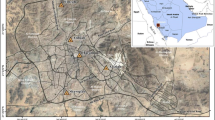Abstract
To assess the surface ozone concentration (O3), there is a need to establish relationship between air pollutants and meteorological parameters. The study was conducted on variation of air pollutants, viz. O3, nitrogen oxides (NOX = NO2 + NO) and carbon monoxide (CO) along with meteorological parameters like temperature (Temp), relative humidity (RH), solar radiation (SR) and wind speed (WS). The precursor gases were recorded in Hyderabad at Tata Institute of Fundamental Research-National Balloon Facility (TIFR-NBF; 17.47° N, 78.58° E). Correlation analysis is done on hourly averaged trace gases concentration and metrological data for the entire year 2016. O3 is in negative correlation with NOX, CO and RH. NOX which is one of the precursor gases plays a major role in formation of O3 by photo-chemical reaction (PCR). The increase in O3 concentration is in proportion with the decrease in NOX concentration. O3 correlated positively with Temp, SR and WS. Two sets of four models were constructed with multiple linear regression (MLR) representing the data for the three seasons (summer, winter and monsoon) and for the total year as well. The adjusted R2 was determined and found to be in the range of 0.6 to 0.9 for the models using precursor gases and 0.9 by meteorological parameters. The models were validated by various performance indicators, viz. root mean square error (RMSE), mean absolute error (MAE) and mean biased error (MBE).





Similar content being viewed by others
References
Abdul-Wahab SA, Al-Alawi SM (2002) Assessment and prediction of tropospheric ozone concentration levels using artificial neural networks. Environ Model Softw 17(3):219–228
Avnery S, Mauzerall DL, Liu J, Horowitz LW (2000) Global crop yield reductions due to surface ozone exposure: 1. Year 2000 crop production losses and economic damage. Atmos Environ 45(13):2284–2296
Booker F, Muntifering R, McGrath M, Burkey K, Decoteau D, Fiscus E, Manning W, Krupa S, Chappelka A, Grantz D (2009) The ozone component of global change: potential effects on agricultural and horticultural plant yield, product quality and interactions with invasive species. J Integr Plant Biol 51(4):337–351
Bowerman BL, O’Connell RT, Koehler AB (2005) Forecasting, time series and regression, 4th edn. Brooks/Cole Thomson Learning Inc., United States of America
Castellano M, Franco A, Cartelle D, Febrero M, Roca E (2009) Identification of NOX and ozone episodes and estimation of ozone by statistical analysis. Water Air Soil Pollut 198(1–4):95–110
Lal S, Naja M, Subbaraya BH (2000) Seasonal variations in surface ozone and its precursors over an urban site in India. Atmos Environ 34(17):2713–2724
Levinm RI, Rubin DS (1994) Statistics for management, 6th edn. Prentice Hall, Englewood Cliffs
Lin CY, Wang Z, Chou CCK, Chang CC, Liu SC (2007) A numerical study of an autumn high ozone episode over southwestern Taiwan. Atmos Environ 41(17):3684–3701
Mazzeo NA, Venegas LE, Choren H (2005) Analysis of NO, NO2, O3 and NOX concentrations measured at a green area of Buenos Aires city during wintertime. Atmos Environ 39(17):3055–3068
Oksanen E, Pandey V, Pandey AK, Keski-Saari S, Kontunen-Soppela S, Sharma C (2013) Impacts of increasing ozone on Indian plants. Environ Pollut 177:189–200
Shavrina AV, Pavlenko YV, Veles AA, Sheminova VA, Synyavski II, Sosonkin MG, Romanyuk YO, Eremenko NA, Ivanov YS, Monsar OA, Kroon M (2010) Tropospheric ozone columns and ozone profiles for Kiev in 2007. arXiv:1003.1211
Stull RB (1988) An introduction to boundary layer meteorology. Kluwer Academic, Boston
Venkanna R, Nikhil GN, Rao TS, Sinha PR, Swamy YV (2015) Environmental monitoring of surface ozone and other trace gases over different time scales: chemistry, transport and modeling. Int J Environ Sci Technol 12(5):1749–1758
Venkanna R, Nikhil GN, Sinha PR, Rao TS, Swamy YV (2016) Significance of volatile organic compounds and oxides of nitrogen on surface ozone formation at semi arid tropical urban site, Hyderabad, India. Air Qual Atmos Health 9(4):379–390
Verma N, Satsangi A, Lakhani A, Kumari KM (2015) Prediction of Ground level ozone concentration in ambient air using multiple regression analysis. J Chem Biol Phys Sci 5(4):3685–3696
Vlachogianni Kassomenos P, Karppinen A, Karakitsios S, Kukkonen J (2011) Evaluation of a multiple regression model for the forecasting of the concentrations of NOX and PM10 in Athens and Helsinki. Sci Total Environ 409:1559–1571
Yerramsetti VS, GauravarapuNavlur N, Rapolu V, Dhulipala NC, Sinha PR, Srinavasan S, Anupoju GR (2013) Role of nitrogen oxides, black carbon, and meteorological parameters on the variation of surface ozone levels at a tropical urban site–Hyderabad, India. Clean–Soil, Air, Water 41(3):215–225
Acknowledgement
The work is carried out under financial support of ISRO-GBP program under ATCTM project. The authors wish to thank Director, Council of Scientific Industrial Research-Indian Institute of Chemical Technology (CSIR-IICT), Hyderabad, for his encouragement and support (IICT/Pubs./2019/414). We also acknowledge Tata Institute of Fundamental Research-National Balloon Facility (TIFR-NBF), Hyderabad, for providing laboratory space.
Author information
Authors and Affiliations
Corresponding author
Additional information
Publisher's Note
Springer Nature remains neutral with regard to jurisdictional claims in published maps and institutional affiliations.
Rights and permissions
About this article
Cite this article
Allu, S.K., Srinivasan, S., Maddala, R.K. et al. Seasonal ground level ozone prediction using multiple linear regression (MLR) model. Model. Earth Syst. Environ. 6, 1981–1989 (2020). https://doi.org/10.1007/s40808-020-00810-0
Received:
Accepted:
Published:
Issue Date:
DOI: https://doi.org/10.1007/s40808-020-00810-0




